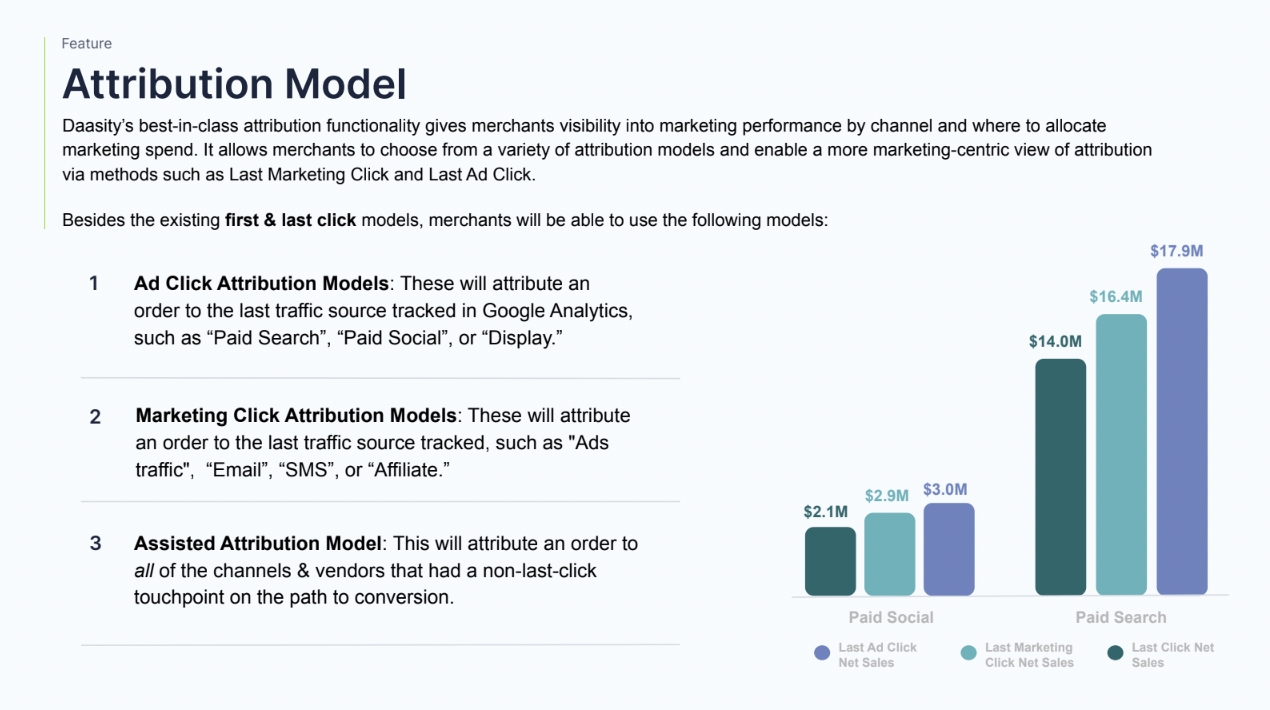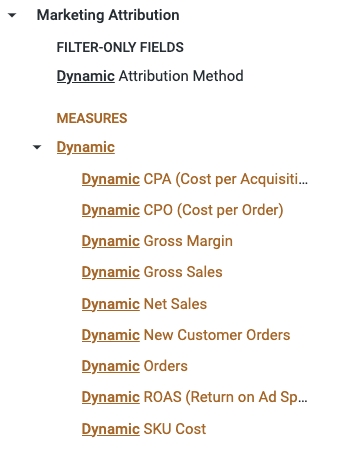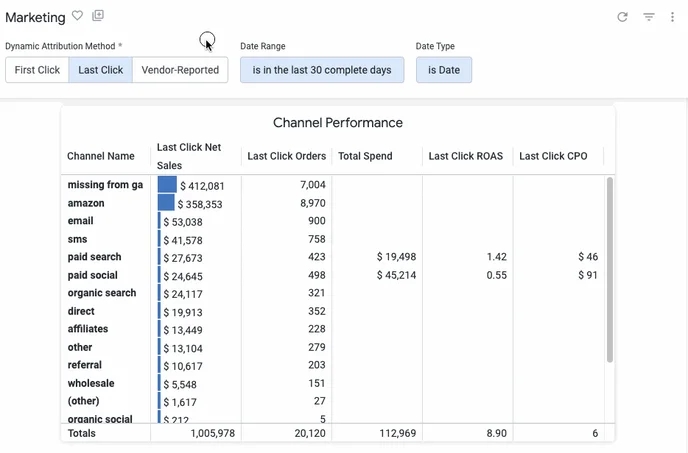Attribution Overview
Marketing attribution helps you understand which marketing channels and tactics are driving your sales, by assigning credit to different touchpoints in the customer journey.
Overview
We make it easy to explore attribution reporting options that are:
Based on actual revenue from your ecommerce store, and
Flexible, so you can analyze performance from multiple perspectives.
To do this, we pull in data from:
Google Analytics
Post-purchase surveys
Discount codes
Brand Supplied Data (BSD) you provide in the Daasity platform
This gives you a range of attribution models and data views—so you can see how different channels contribute to your sales and optimize your marketing accordingly.
Where to see attribution data
You can access attribution data in different parts of the Daasity platform, depending on how you want to analyze it:
🔍 Order-Level Attribution
To see attribution at the individual order level, use the Order Attribution view. This is helpful when you want to drill into specific orders and understand exactly how a customer arrived at that purchase.
Available in:
Order & Order Line Revenue
Transactional Sales explores
👤 Customer-Level Attribution
To view attribution across a customer’s journey—especially their first, second, and last orders—use the Customer RFM & First/Second/Last Order view. This is ideal for understanding lifecycle marketing impact or acquisition vs retention performance.
Available in:
LTV Time Series
Any explore that includes a Customer ID (e.g., Order & Order Line Revenue)
📊 Aggregated Attribution
For a high-level view across your business, the Marketing Attribution explore aggregates order-level data by channel and vendor.
Use this to:
Calculate metrics like ROAS and CPA
Compare Daasity-attributed performance to vendor-reported data from platforms like Meta or Google Ads
Order-level data — To see attribution information where you can drill down to information about individual orders, you can use the Order Attribution view, which is available in the Order & Order Line Revenue and Transactional Sales explores.
Customer-level data — You can see attribution values for each customer's first, second, and last orders using the Customer RFM & First/Second/Last Order view. This view is available in customer-centric explores like LTV Time Series, but is also available in any explores that contain a customer ID, like Order & Order Line Revenue.
Aggregated data — You can see aggregated attribution info in the Marketing Attribution explore. This explore rolls up order-level attribution data to the channel and vendor level so that you can calculate metrics like ROAS and CPA as well as compare the results to the vendor-reported numbers from your ad platforms.
Attribution models
Survey-Based attribution
Survey-Based attribution relies on information submitted from your customers through post-purchase surveys. For example, if your customer answers the "How did you hear about us?" question in a Fairing post-purchase survey, this information will be reflected in Survey-Based attribution dimensions.
-> Learn more about Survey-Based attribution
Discount Code attribution
Discount Code attribution assigns credit to different channels and vendors based on the discount code value associated with an order.
-> Learn more about Discount Code attribution
Google Analytics-based attribution models (First Click, Last Click, and Assisted)
All of the following models give you different perspectives on attribution using Google Analytics data:
Last Click — Attributes credit to the traffic source that initiated the session in which a user made a purchase.
First Click — Attributes credit to the first traffic source the user interacted with in the 30 days prior to the purchase.
Assisted — Assigns credit for an order to every non-last-click traffic source that the user interacted with in the 30 days prior to purchase. Think of this as "non-last-click" attribution.
Last Click + Assisted — Combines Last Click and Assisted attribution models. Think of this as "any click" attribution because a traffic source will get credit for the order if there was a touchpoint at any point in the 30 days prior to purchase.
Last Ad Click — Attributes credit to the last advertising channel the user interacted with before making a purchase. i.e. Paid Search, Paid Social Display
Last Marketing Click — Attributes credit to the last marketing channel the user interacted with before making a purchase. i.e Ads Traffic, Email SMS or Affiliate.

-> Learn more about First Click, Last Click, and Assisted attribution models
Custom Attribution
Custom Attribution lets you use a waterfall approach to sift through multiple attribution data sources for a single order and return a single channel and vendor value based on the priority you specify in the Daasity app.
-> Learn more about Custom Attribution
Vendor-Reported attribution
Vendor-Reported attribution shows the performance metrics straight from your marketing platforms.
-> Learn more about Vendor-Reported attribution
Dynamic attribution measures
In the Marketing Attribution explore, there is a set of "Dynamic" fields:

These dynamic measures aren't actually a separate attribution model. Rather, you can place these measures in your reports, and then use the Dynamic Attribution Method filter-only field to choose which attribution measures should be reflected in the dynamic measures. This enables you to quickly flip back and forth between methods without having to overload your reports with different measures:

Last updated
Was this helpful?